Effective capacity planning ensures that your organization’s resources, like employees, technological tools, or your team’s efforts, are optimally used to meet project demands.
If your resources are not properly utilized, it could result in resource wastage and project delay. By being strategic and through planning, you can avoid the pitfalls and ensure that your projects run smoothly from the start.
This is where capacity planning tools find their place, from managing resources, priorities, deadlines, anticipating demands, and ensuring seamless project execution. A capacity planning tool can make your life a lot easier.
In this article, we will discuss the top capacity planning tools, their features, benefits, and the pivotal role they play in managing projects efficiently. Let’s get started.
What is a capacity planning tool?
A capacity planning tool helps you monitor your team and evaluate their capacity. These tools help you in managing projects effectively and forecasting resource allocation for managing deadlines.
This tool helps you to oversee the workflow and strategically manage resources for upcoming projects. Further, you are able to analyze the number of members in your team and a detailed report of the workload of each member.
10 Best team capacity planning tools
Before choosing the right capacity planning tool for your team, you need to set up your expectations and requirements for that software. Select a tool that matches the specific requirements of your team.
This review of the top 10 tools will simplify this process for you, so you can start forecasting resources for your team right away.
1. ProofHub
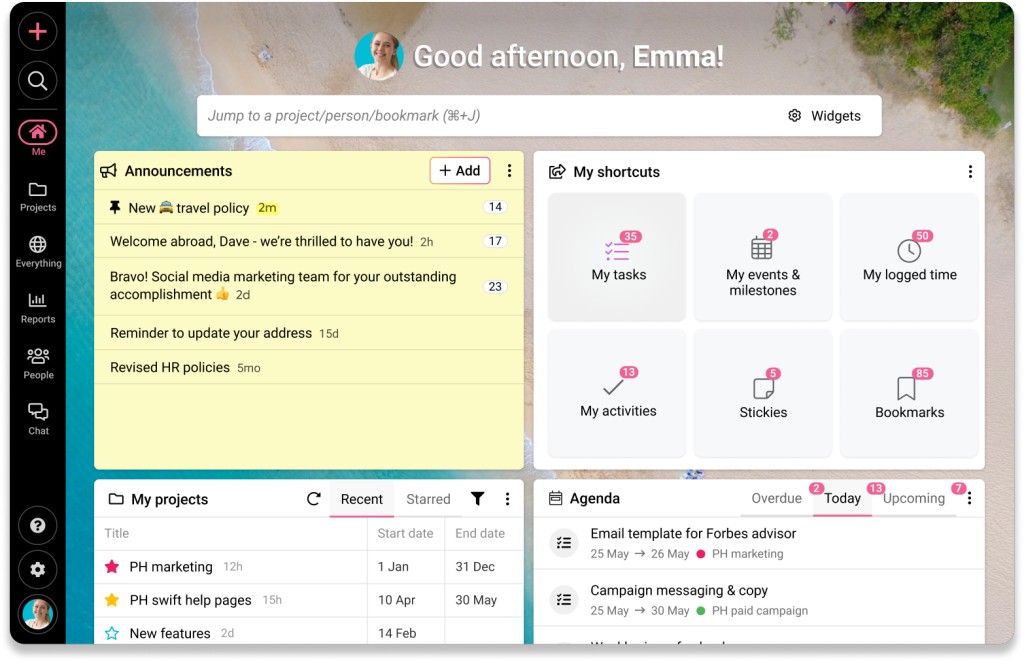
Having any capacity planning tool will not provide a complete project planning solution. You need to have a tool that will suit the exact requirements of your organization.
And this is the reason for us to mention ProofHub in the first spot.
ProofHub is an all-in-one project management and team collaboration tool that provides you with outstanding features for forecasting and capacity planning for your team.
It is versatile enough to have the ability to adapt to the needs of any team. So you can manage resources with ease, as well as manage projects and collaborate with your team all on the same platform.
Key features
- Task management with deadlines and progress tracking to keep projects on schedule.
- Gantt charts, Kanban boards, and custom workflows to visualize projects and define processes.
- Resource allocation and workload management with reports and trend analysis to prevent overbooking and burnout.
- Built-in time tracking, timesheets, and time estimates to forecast resources and avoid delays.
- Collaboration features like chats, discussions, announcements, notes, and online proofing for quick communication and approvals.
- Bird’s-eye workload view to monitor team capacity and adjust workloads effectively.
- Consolidated project reports to track performance and identify improvement areas.
- Integrations with QuickBooks, Google Drive, Google Calendar, Dropbox, and more for seamless workflows.
Pros
- Easy-to-use and intuitive interface.
- Flat pricing model with no per-user fee, making it a budget-friendly option.
- Centralized platform that improves collaboration and keeps everyone on the same page.
- Provides transparency and accountability with built-in time tracking and reports.
Cons
- Notifications can be overwhelming sometimes
- No free plan is available (only a 14-day trial).
Pricing
ProofHub provides flat pricing. That means you can add as many users to your team without affecting your overall cost. There are no hidden charges.
- The essential plan costs $45 per month (billed annually)
- The ultimate control costs $89 per month (billed annually)
Ratings
- Capterra: 4.5/5
- G2: 4.6/5
2. Runn
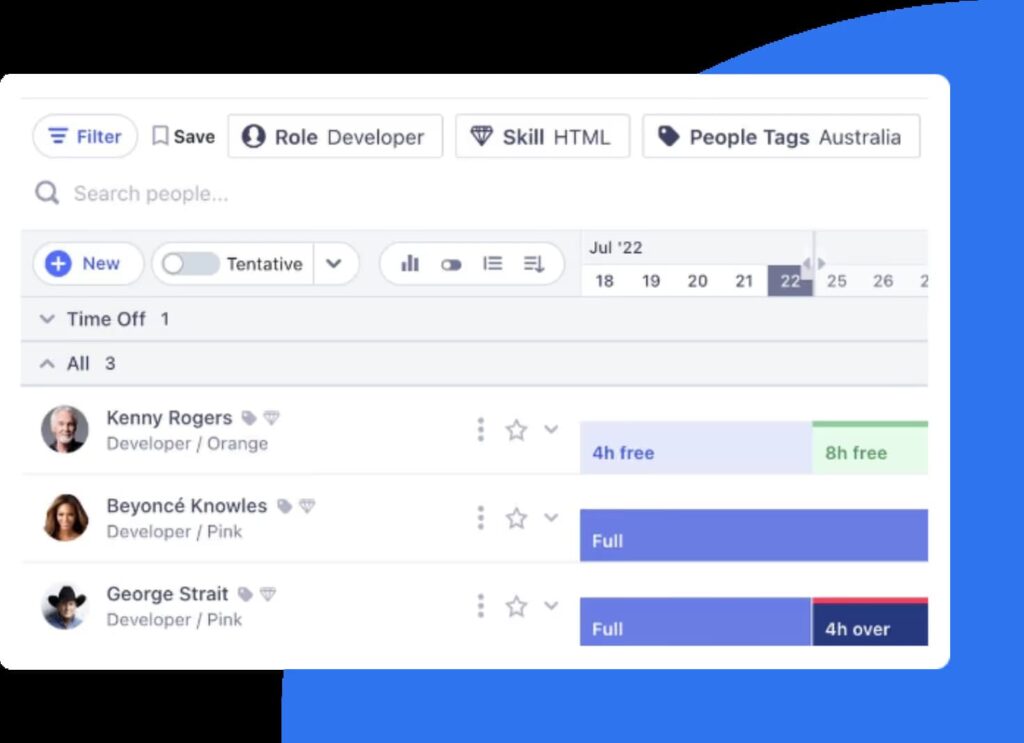
Runn stands out for its real-time resource optimization and easy drag-and-drop scheduling. This helps you plan and forecast future activities swiftly.
Runn offers you the unique ability to attach placeholders as an indication of open designations. While forecasting, you can also set hiring reminders and plan recruitment needs in advance. However, this tool is mostly favorable for financial organizations, and other businesses may find the features user-friendly and adaptable.
Key features
- Real-time drag-and-drop planning enables you to get instant feedback and fill gaps.
- Timesheets provide you with analytical reports between the actual time of working vs the planned time.
- Quickly glance through the project to understand hiring requirements for both short-term and long-term goals.
Pros
- A single place for arranging all your strategies.
- Analyze financial trends to identify the most profitable clients.
- Provides a calculative approach for upcoming bills to the organization.
Cons
- Lack of customization features.
- Limited reports and permission levels.
Pricing
Runn offers three pricing plans to choose from
- Starter: $10/user per month
- Professional: $14/use per month
- Premium: Custom pricing
Ratings
- Capterra: 4.8/5
- G2: 4.5/5
3. Toggl plan
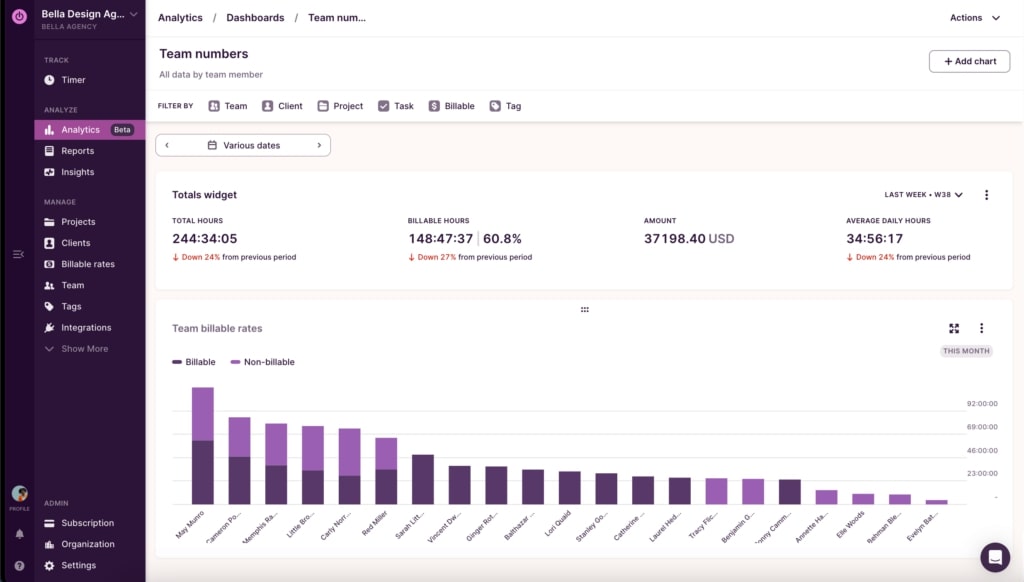
Toggl plan is best suited for your team if your main motive is keeping track of work hours. You can quickly see the project progress and resolve bottlenecks by efficiently planning the workload for your team accordingly.
However, there is a slight mismanagement in the pricing categories and the features you get. This means you may have to pay extra for just one additional feature, while the rest of the features remain underutilized for you.
Key features
- Best suited for small teams for quick allocation of resources.
- Schedule tasks in a jiffy – quickly analyze the workload on your team, and schedule upcoming tasks for your team.
- Access files and share them on the centralized platform.
Pros
- Easy to use and clean interface.
- Extensive list of reporting mechanisms.
- Team timeline for ensuring that your team is on track.
Cons
- Not friendly for mobile users.
- No version history – accidental deletion leads to loss of data.
Pricing
Apart from the free plan, the Toggl plan offers three paid plans
- Capacity: $5/user per month
- Starter: $8/user per month
- Premium: $13.5/user per month
Ratings
- Capterra: 4.6/5
- G2: 4.3/5
Looking for similar tools: Read – 14 Best Alternatives to Toggl
4. Saviom
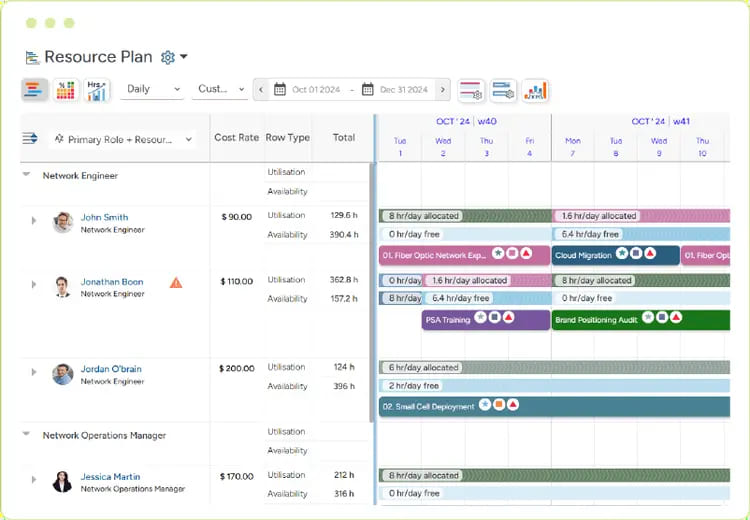
Saviom lets you dynamically manage your workforce – literally from anywhere. Gantt Charts are the biggest plus for this tool as they provide a quick view of the resource distribution in your team.
However, you may notice that your customers/clients will not be able to add any manual field to the task list. They will be forced to use only the preset format.
Key features
- Provides you with detailed reports on the utilization of resources for projects and tasks.
- Skill management features help you identify the areas that require improvement in your team.
- Create different scenarios for managing the capacity of your team on the basis of assumptions and scenarios.
Pros
- Drag and drop feature for task reallocation/ modification.
- Quickly hide the features that you don’t want in the current task.
- Analyze historical data and trends efficiently for precise forecasting.
Cons
- Limited customization features
- Clients/customers cannot add custom fields; they can use the available format only.
- Mapping and integration are a big hassle
Pricing
Contact their sales team for prices!
Ratings
- Capterra: 4.3/5
- G2: 4.5/5
5. Resource Guru
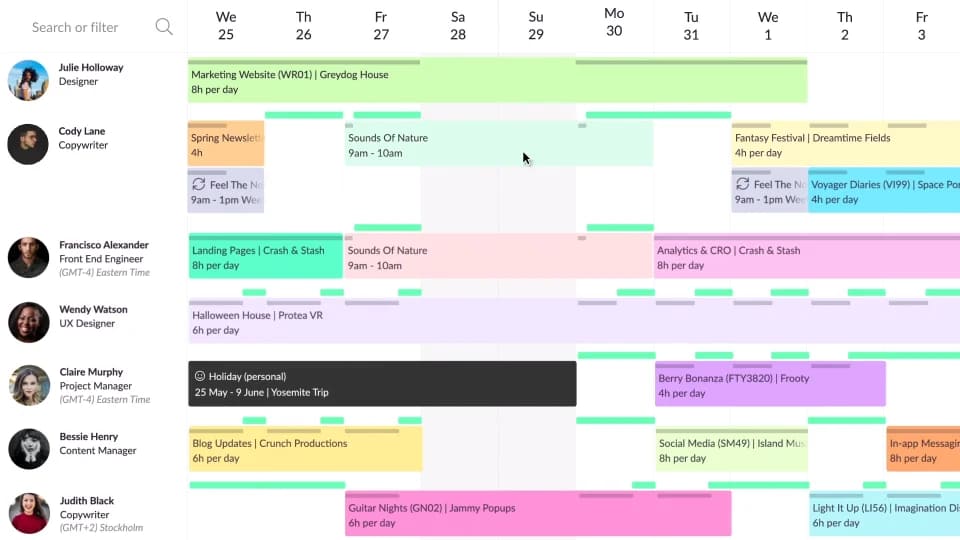
With Resource Guru, managing your team’s schedules and workloads becomes simple and efficient. You get a drag-and-drop feature to create tasks and allocate resources effectively. You can easily monitor the performance of your team, so you can precisely forecast future trends and requirements.
However, in rare situations when you select a short duration for any task, the tool does not send you any warning of the same. Automation is very minimal, and so are analysis and prediction.
Key features
- You can view the availability of your team members. This way, you can effectively plan and schedule tasks.
- Custom options for days off, holidays, and working hours. Thereby, providing you with the option for better forecasting for your project.
- Detailed reports on the past performance of the team helps in simplifying the decision-making process.
Pros
- Intuitive functions and easy to use.
- Simple onboarding process with a minimum learning curve.
- Drag and drop feature lets you change task details effortlessly.
Cons
- Repetitive events or holidays are not available – need to create them manually every time.
- Exporting reports is a hassle.
Pricing
Resource Guru offers three paid plans to choose from
- Grasshopper Plan: $5/month per user (billed annually)
- Blackbelt Plan: $8/month per user (billed annually)
- Master Plan: $12/month per user (billed annually)
Ratings
- Capterra: 4.7/5
- G2: 4.6/5
6. Float
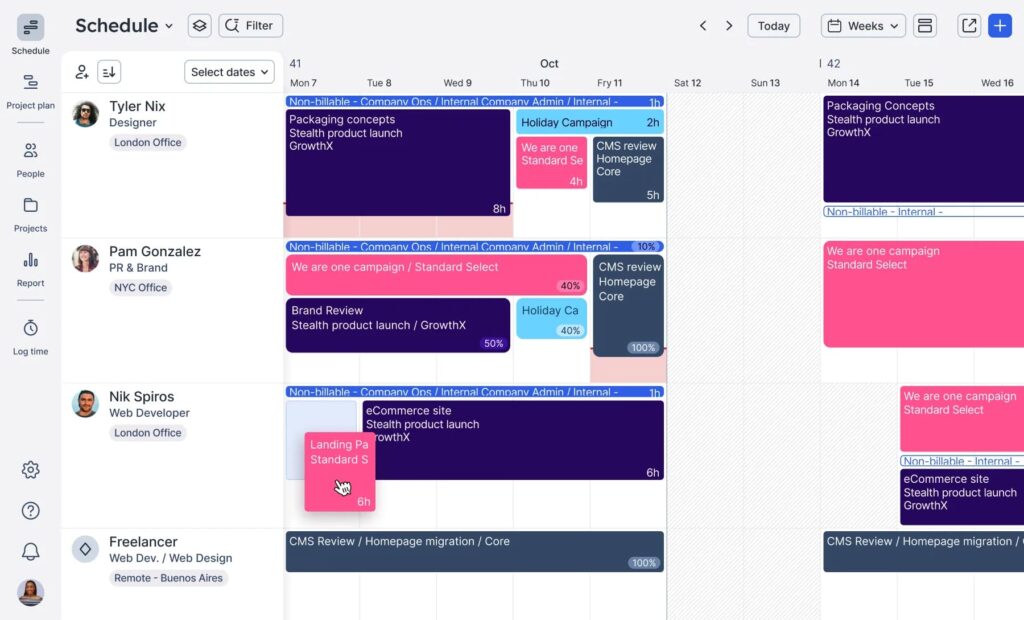
Float is a cloud-based resource management software that is easy to use. It offers a visual team planner and resource scheduling. You can plan projects, schedule your team’s time, and track budgets in real time.
It integrates with popular project management tools to keep scheduling connected with ongoing work. You can also add the estimated time it will take to finish a task to check whether it will be completed within the deadline. This makes it suitable for large teams or teams working on multiple projects simultaneously.
Key features
- Visual team scheduling with drag-and-drop controls to assign tasks and balance workloads.
- Set project budgets based on hours or fees, and track progress in real time.
- Manage time off, public holidays, and sick leave directly within the schedule.
- Integrates with tools like Asana, Jira, Trello, Slack, Google Calendar, and Outlook.
Pros
- Quick onboarding and easy to use.
- Clean, visual interface makes resource planning intuitive.
- Helps prevent overbooking by showing real-time availability and capacity.
Cons
- Native integrations are good, but fewer than some enterprise tools.
- Prices may feel higher compared to leaner competitors.
- Customization options are somewhat limited.
Pricing
Float offers three paid plans
- Starter: $7/user per month billed annually
- Pro: $12/user per month billed annually
- Enterprise: Custom pricing
Ratings
- Capterra: 4.5/5
- G2: 4.3/5
7. Milient
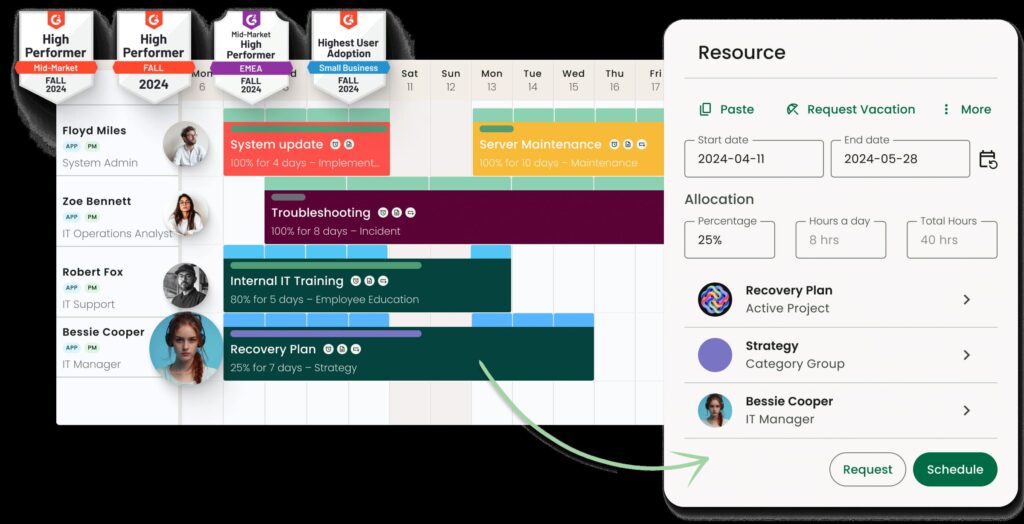
Milient, formerly known as Hub Planner, helps teams gain clear visibility into resource allocation and ensures transparent workload management. It provides strong visibility into who is working on what, making scheduling easier to manage. Another thing the tool is good at is the number of customization options available.
However, you will not be able to input a time less than half an hour. This means there are limited options when it comes to reporting.
Key features
- Transparency helps you to quickly identify gaps in the schedule.
- Powerful filter option to identify team members who are over-scheduled.
- Streamline projects to ensure a smooth progression in tasks.
Pros
- Customizable and easy to use.
- Pre-formatted templates that can be changed easily.
- Use the tool to plan non-work-related activities like vacations or conferences.
Cons
- Real-time tracker is not available.
- Correcting mistakes needs administrator permission.
- Multiple issues with decimals when exporting time details to Excel.
Pricing
Milient offers three paid plans
- Plug and Play: $7/resource per month (billed annually)
- Premium: $18/resource per month (billed annually)
- Business Leader: $54/resource per month (billed annually)
Ratings
- Capterra: 4.5/5
- G2: NA
8. TeamUp
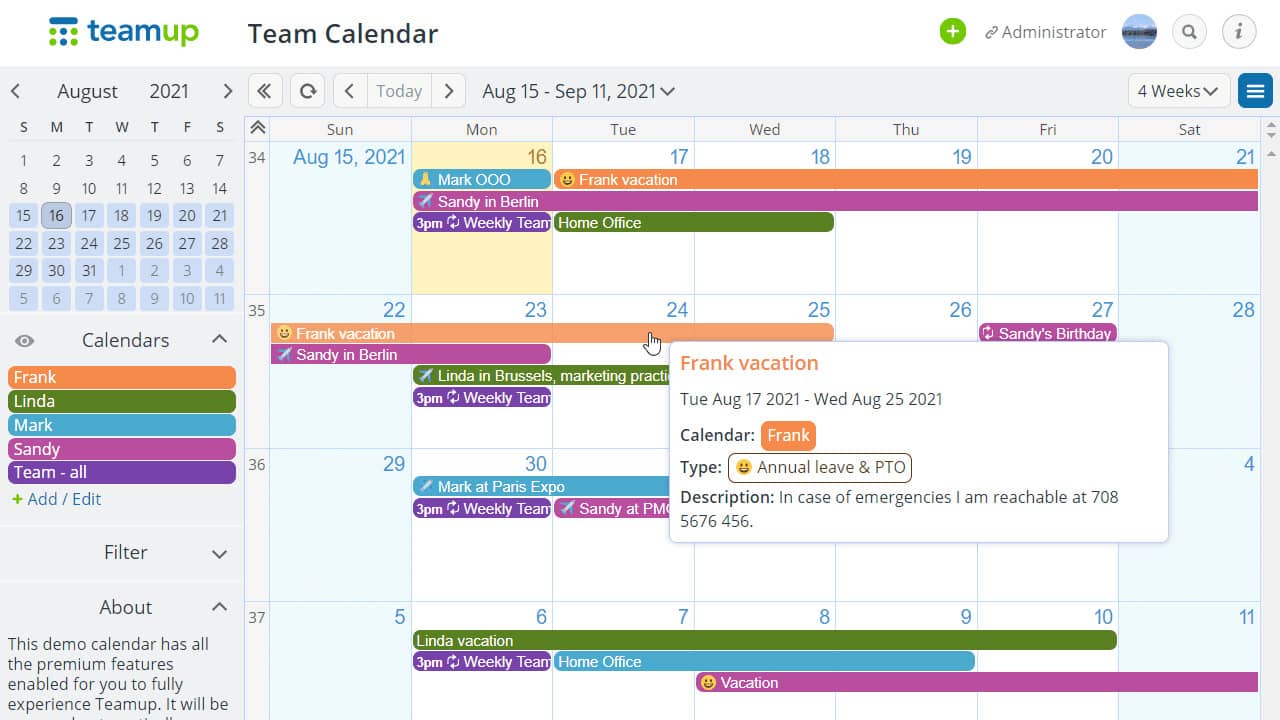
Teamup is a calendar solution built for scalable collaboration with unique calendar views and customizable access for team members.
The tool is a calendar at its core. It allows you to create color-coded sub-calendars for each team member. Team members can add their schedules to the calendar and see everyone’s availability on the calendar. You can also add details and notes to each scheduled job, and attach files, images, and links. It integrates smoothly with other calendar apps, enabling you to sync external schedules for a unified view.
It may not replace your project management software, but it can be a great addition to your digital toolbox.
Key features
- Centralized platform for organizing and sharing all your files, notes, and even time-stamped comments.
- Assign events to multiple calendars. They can be directly forwarded to other people through messaging, email, or social media.
- Quickly understand where your team members are spending their time. The transparency promotes healthy collaboration and reduces information silos.
Pros
- Keep all information in context and use built-in filters to find key details.
- One-touch system to load and get addresses/ directions right from your calendar.
- Quickly view the occupied dates of your team members.
- Work with calendar data in unique calendar views for better insights.
- Allow team members to add their schedules and update task status.
Cons
- Users seeking more advanced project management or automation capabilities might find it lacking.
- Offline capabilities are limited to mobile apps.
- It may take some time for users to explore and fully grasp all the features and customization options.
Pricing
Teamup provides a free plan with up to 8 sub-calendars and 8 account users, along with four paid plans:
- Plus: $10/month per calendar, billed annually (excluding VAT)
- Pro: $25/month per calendar, billed annually (excluding VAT)
- Business: $60/month per calendar, billed annually (excluding VAT)
- Enterprise: $105/month per calendar, billed annually (excluding VAT)
Ratings
- Capterra: 4.8/5
- G2: 4.6/5
9. Ganttic
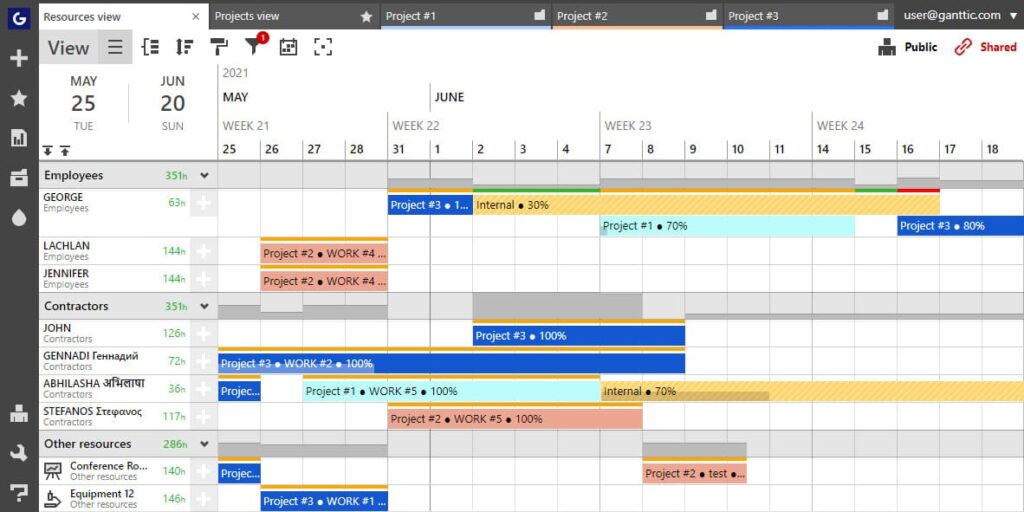
Ganttic lets you work with high efficiency. We found the ‘rotate Gantt chart’ feature particularly valuable, as it allows you to switch views between tasks and resources. You can view your chart from the perspective of tasks or resources. This helps you to understand resource utilization.
However, Ganttic is a bit overwhelming. At first, the features and customizations may prove to be difficult for the user. There is a moderate learning curve for this tool.
Key features
- Schedule future tasks while keeping track of the existing responsibilities of your team members.
- Portfolio management helps to prevent conflicts and boost productivity.
- Matrix view helps you to work on multiple projects at the same time.
Pros
- Quick and clear overview of who is working on which project.
- Calculate travel time and analyze time spent in transit.
- Real-time updates help in quickly transferring messages among the team.
Cons
- Drafts are not private
- Time blocks are fixed and cannot be split
Pricing
- Up to 10 resources: $0/month per resource (billed annually)
- Up to 20 resources: $12.50/month per resource (billed annually)
- Up to 50 resources: $11.80/month per resource (billed annually)
- Up to 150 resources: $9.93/month per resource (billed annually)
- Up to 250 resources: $9.16/month per resource (billed annually)
- Up to 500 resources: $7.58/month per resource (billed annually)
- Up to 1000 resources: $5.99/month per resource (billed annually)
- Up to 1500 resources: $5.27/month per resource (billed annually)
- More than 1500 resources: Custom pricing
Ratings
- Capterra: 4.3/5
- G2: 4/5
10. Harvest Forecast
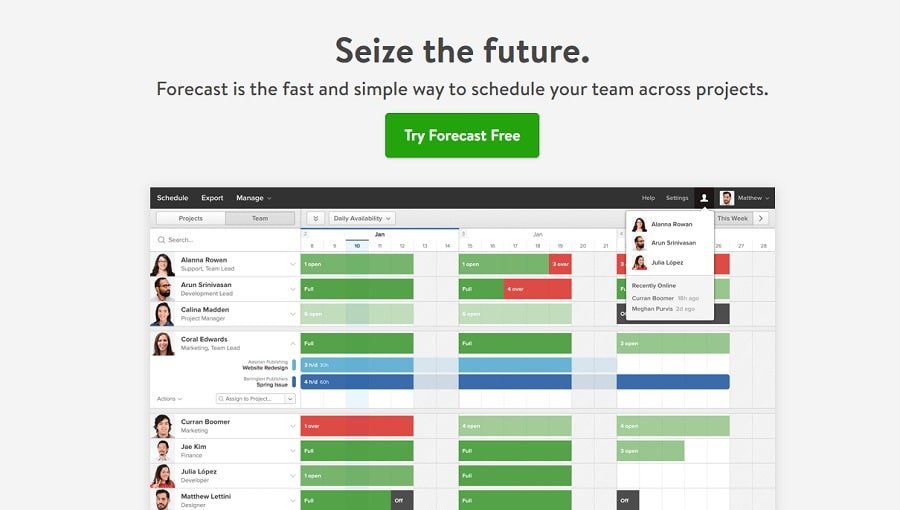
Forecast by Harvest (commonly known as Harvest Forecast) is a capacity planning and team scheduling tool that helps managers visualize workloads, assign resources, and anticipate upcoming needs. It integrates seamlessly with Harvest’s time tracking and invoicing, creating a smooth workflow between scheduling and financial reporting.
Forecast focuses on clarity and simplicity rather than complex automation, making it easy to adopt for teams of all sizes.
Key features
- Efficiently balance resources across your available pool, ensuring equal distribution of load to everyone.
- The placeholders save on the expenditure by hiring only when essential.
- Clear capacity views for project and team scheduling.
- Integration with Harvest time tracking for budget awareness.
Pros
- Clean, intuitive visual scheduling interface.
- Easy adoption for small to mid-sized teams, with minimal training required.
- Seamless integration with Harvest for connected scheduling, time tracking, and budgeting.
Cons
- Limited customization for enterprise needs.
- May feel lightweight for very large teams.
Pricing
$5 per user/ month when billed annually
Ratings
- Capterra: 4.2/5
- G2: 4.1/5
Benefits of capacity planning software
Adopting a capacity planning tool can transform how your team manages projects and resources. Here are the main benefits:
- Improved resource utilization: Ensures employees, tools, and budgets are allocated effectively.
- Increased transparency: Gives stakeholders a clear view of availability, schedules, and workloads, reducing confusion and miscommunication.
- Reduced project delays: By identifying bottlenecks early and redistributing workloads, teams can prevent last-minute slowdowns.
- Higher employee satisfaction: Prevents burnout by balancing workloads fairly, while also giving teams clarity on expectations.
- Faster decision-making: Real-time visibility into workloads and availability helps managers respond quickly to changes in demand or priorities.
- Scalability and adaptability: Makes it easier to manage resources as teams grow or as project complexity increases.
Key features to look for in capacity planning software
When choosing a capacity planning tool, it’s important to make sure it includes the right features to help you manage resources effectively. Here are the key features to look out for:
- Drag-and-drop scheduling: Simplifies workload allocation and allows managers to quickly adjust tasks or resources in real time.
- Forecasting and scenario planning: Provides visibility into upcoming projects, helps simulate “what-if” situations, and ensures you’re prepared for changes in demand.
- Workload visibility and reporting: Offers dashboards and reports that show how resources are being used, preventing over-allocation or under-utilization.
- Time tracking: Built-in tools to track actual time versus planned time, helping managers prevent burnout.
- Customization and flexibility: Adapts to your team’s unique workflows with custom fields, views, or filters.
- Scalability: Ensures the software grows with your team, whether you’re managing a small group or a large organization.
- Mobile access: Allows team members and managers to update schedules and check workloads on the go.
- Security and compliance: Protects sensitive data with robust security features, user permissions, and compliance with industry standards.
How to choose the best capacity planning tool
Selecting the right capacity planning tool depends on your team’s size, workflows, and long-term goals. Here are some key factors that can help you select the best tool for your team.
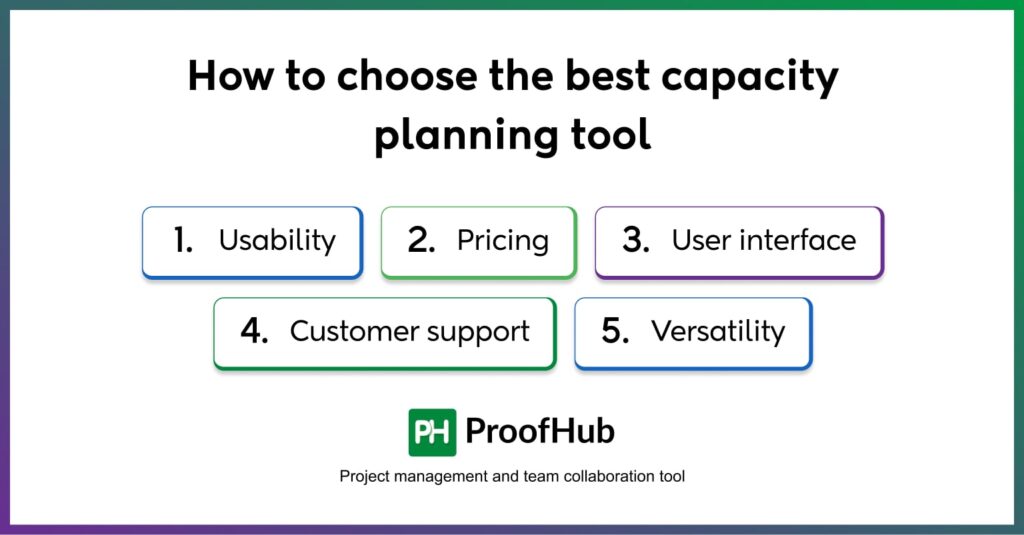
1. Usability
The primary focus should be on the learning curve. You do not want your team to put in additional effort learning how to use this tool. A simple and smooth learning curve will ensure minimal hindrance to the workflow.
2. Pricing
The tool must be budget-friendly and offer good value for money. You will never want a tool that burns a deep hole in your pocket on the pretext of making your team work effectively.
3. User interface
How does a tool present itself to users? A simple and user-friendly interface will help you, as well as your team, to quickly understand all the features and functionality. You do not want to pay for a feature that is too hard to use!
4. Customer support
A tool that offers quick support is necessary to remain on track always. Your team will feel at ease working with the tool if they have quick assistance in case of any downtime or other issues.
5. Versatility
When choosing a capacity planning tool, look for options that can help you use the tool for managing projects as well as for team collaboration. This will improve ROI and also make this an all-in-one favorite tool for your team.
Conclusion
Capacity planning tools are essential for teams aiming to improve efficiency and meet deadlines. Investing in the right tool is essential for any team that wants to improve efficiency and achieve better results.
With so many options available, it’s easy to feel overwhelmed. The key is to choose software that not only helps with forecasting and resource planning but also supports collaboration, reporting, and overall project management.ProofHub, for example, combines all of these capabilities into one platform, making it easier to plan, manage, and deliver projects without juggling multiple tools. Start your free trial of ProofHub today and see how it can improve your workflow!
Frequently asked questions
What is capacity planning?
Capacity planning is the process of determining the optimal amount of resources needed to meet future demand and ensure efficient use of available resources.
What types of capacity planning software are available?
There are various types of capacity planning tools, including spreadsheets, simulation software, analytic tools, and enterprise resource planning (ERP) systems.
What industries can benefit from capacity management software?
Manufacturing, transportation, healthcare, hospitality, and retail are some of the industries that can benefit from capacity management tools to optimize resource utilization and improve operational efficiency.
What are the best practices for using team capacity planning tools?
Some best practices for using resource capacity planning tools include setting realistic goals, regularly updating data, involving stakeholders, and considering different scenarios.

